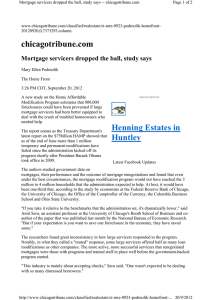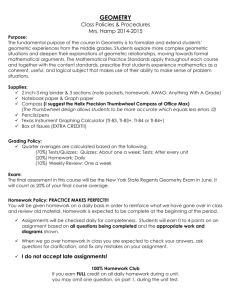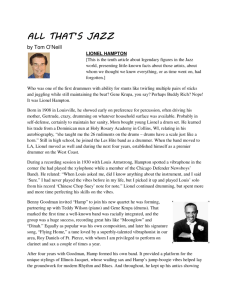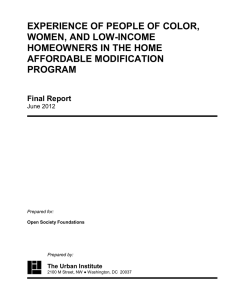Study: Home modification program falls short
advertisement
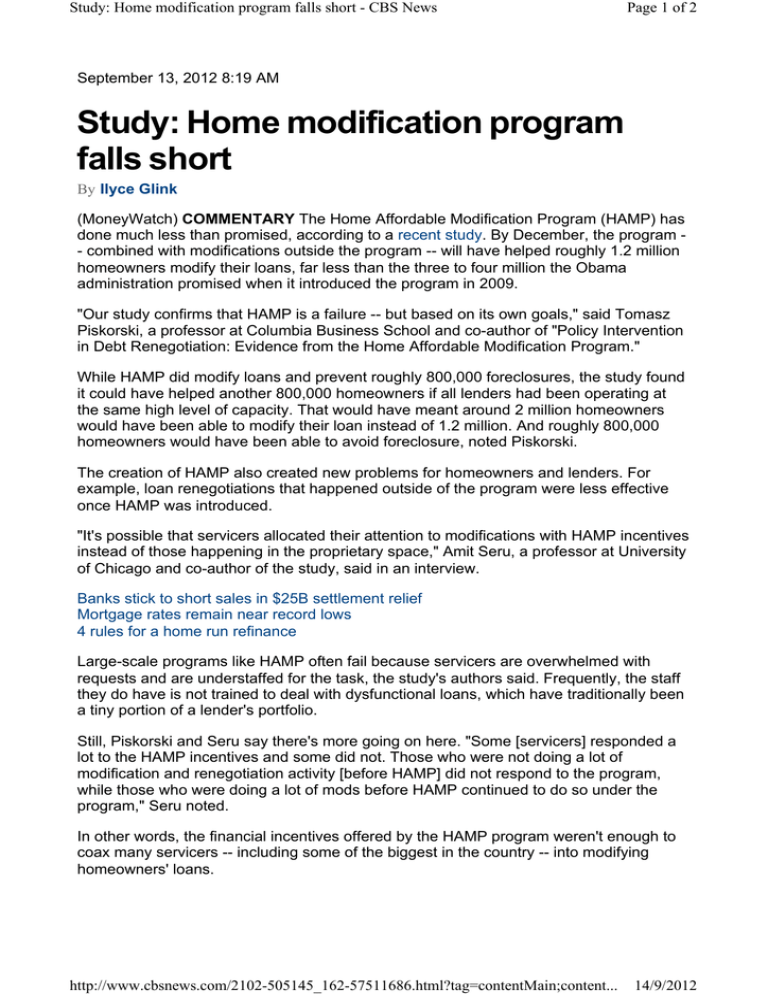
Study: Home modification program falls short - CBS News Page 1 of 2 September 13, 2012 8:19 AM Study: Home modification program falls short By Ilyce Glink (MoneyWatch) COMMENTARY The Home Affordable Modification Program (HAMP) has done much less than promised, according to a recent study. By December, the program - combined with modifications outside the program -- will have helped roughly 1.2 million homeowners modify their loans, far less than the three to four million the Obama administration promised when it introduced the program in 2009. "Our study confirms that HAMP is a failure -- but based on its own goals," said Tomasz Piskorski, a professor at Columbia Business School and co-author of "Policy Intervention in Debt Renegotiation: Evidence from the Home Affordable Modification Program." While HAMP did modify loans and prevent roughly 800,000 foreclosures, the study found it could have helped another 800,000 homeowners if all lenders had been operating at the same high level of capacity. That would have meant around 2 million homeowners would have been able to modify their loan instead of 1.2 million. And roughly 800,000 homeowners would have been able to avoid foreclosure, noted Piskorski. The creation of HAMP also created new problems for homeowners and lenders. For example, loan renegotiations that happened outside of the program were less effective once HAMP was introduced. "It's possible that servicers allocated their attention to modifications with HAMP incentives instead of those happening in the proprietary space," Amit Seru, a professor at University of Chicago and co-author of the study, said in an interview. Banks stick to short sales in $25B settlement relief Mortgage rates remain near record lows 4 rules for a home run refinance Large-scale programs like HAMP often fail because servicers are overwhelmed with requests and are understaffed for the task, the study's authors said. Frequently, the staff they do have is not trained to deal with dysfunctional loans, which have traditionally been a tiny portion of a lender's portfolio. Still, Piskorski and Seru say there's more going on here. "Some [servicers] responded a lot to the HAMP incentives and some did not. Those who were not doing a lot of modification and renegotiation activity [before HAMP] did not respond to the program, while those who were doing a lot of mods before HAMP continued to do so under the program," Seru noted. In other words, the financial incentives offered by the HAMP program weren't enough to coax many servicers -- including some of the biggest in the country -- into modifying homeowners' loans. http://www.cbsnews.com/2102-505145_162-57511686.html?tag=contentMain;content... 14/9/2012 Study: Home modification program falls short - CBS News Page 2 of 2 "Usually, servicing is basically about taking checks from borrowers and sending them to investors, etc. This was the business these servicers [who weren't doing modifications] were in," Seru added. Instead of taking advantage of HAMP, these servicers opted instead to continue business as usual. That way, they wouldn't have to add more staff, train personnel, upgrade their support systems and essentially change their ways of doing business. Supporters of HAMP believe the program, while a failure by its own terms, changed the framework for servicing loans -- but this study reveals that's not the case. Servicers who weren't doing modifications before HAMP aren't really doing them now, or if they are, they're not doing them in large numbers. And there had been a trend toward more loan renegotiations before HAMP was ever implemented. So what does all of this mean for homeowners? Quite a bit, as it turns out -- even if they're not participating in the HAMP program. According to the results of the study, not only did HAMP not do much for homeowners, it also didn't do much to stimulate the economy, either -- even in areas where modifications within the program were prevalent. Housing prices didn't really improve, employment levels remained the same and there wasn't much change in consumption of durable goods. "You might expect that if neighborhoods start getting better, people would start consuming, but that didn't happen. This reinforces the fact that the program response was not as much as the administration had hoped," Seru noted. One of the most interesting findings of the study is the difference between how commercial real estate and residential real estate lenders deal with delinquencies and loan failures. It turns out that commercial real estate lenders are used to having loans fail and having to develop workout plans for them. That framework doesn't exist in the residential lending world, the study's authors say, and it has caused tremendous hardship. I'll write more about that in tomorrow's post. © 2012 CBS Interactive Inc.. All Rights Reserved. http://www.cbsnews.com/2102-505145_162-57511686.html?tag=contentMain;content... 14/9/2012



